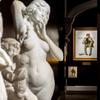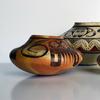Leda and the Swan throughout Art History
- February 15, 2020 16:14


Perhaps one of the most prevailing subjects in the history of art is the tale of Leda and the swan. Derived from Greek mythology, the story appeared in Greco-Roman art and antiquities, re-emerging during the Renaissance as a recurrent motif in erotic art, and it is still explored to this day by contemporary artists and photographers. How has one subject held the fascination of both artists and art lovers for so many centuries? Read on as we dive into the history of this tale.
According to myth, Leda, the Queen of Sparta and wife to King Tyndareus, was one of the great loves of Zeus. He came to her in the form of a swan and seduced her while she bathed by a river. There are a few varying narratives that emerge in written histories, but it is generally held that Leda also slept with her husband later that day, resulting in the birth of not one, but two sets of twins — Helen (of Trojan War fame) and Polydeuces, the children of Zeus, and Castor and Clytemnestra, the children of Tyndareus.
Leda and her divine lover first appeared in sculpture from antiquity, most notably in a lost work by the Greek sculptor Timotheus. Yet, it took until the Middle Ages and the Renaissance for this theme to really gain traction. The question is, why? During this period, the Church had a remarkable influence over the art that was being created. Certainly, the Church and other religious figures were the greatest patrons of the arts, and as a result, many of the works that were being painted used biblical tales and figures as their subjects.
However, the Renaissance was also an age of enlightenment, when Humanism began to emerge alongside great strides in science and philosophy. Artists had a wish to explore deeper themes in their art, sexuality being one of them. Due to the influence of the Church, human sexuality could not be explicitly portrayed. As a result, Leda’s union with not a man, but a swan, became a highly popular way to explore human sexuality without angering religious sensibilities.
This may seem entirely backwards to us today — certainly one would think bestiality is a greater sin than human sexuality. Yet, within the strictures of 16th-century Italy, Leda’s seduction by her swan lover was the more acceptable subject. The result is a wealth of extraordinary imagery from the likes of Leonardo da Vinci and Michelangelo that explore both the act of Leda and Zeus’ sexual encounter, as well as the result.
A version of the scene from the workshop of Bartholomaeus Spranger currently in the collection of M.S. Rau is an example of the latter form. Dating to the late 16th century, this piece captures Leda as a languishing and voluptuous nude; Zeus, in the form of a swan, hovers over her figure in the background. Their children, Helen and Polydeuces, surround their mother. They are shown has having recently hatched from an egg, a popular trope that is a nod to the swan-form of their divine father.
While the subject briefly fell out of favor following the Renaissance, it became popular again with Academic artists of the 19th century. These artists, painting in the Neoclassical style, looked to antiquity and the Renaissance for inspiration, and naturally the theme of Leda and the swan was once again adopted with enthusiasm.
A particularly lovely example by the Orientalist painter Jean-Léon Gérôme is also in M.S. Rau’s collection. Masterfully composed, the oil depicts Leda welcoming her lover, who is surrounded by a group of putti symbolic of their love and intimacy. While Leda’s tale is one of seduction, the mythological anecdote plays a secondary role in this composition compared to Gérôme’s exploration of the female nude. Indeed, many of the works from this period direct their focus towards the form and grace of the figure rather than the exploration of any inherent sensuality. It makes compositions such as Gérôme particularly beautiful examples of the mythological tale.
One might think that contemporary artists would abandon the theme as taboo, but that has proven to be false. In fact, the subject is as popular as ever. Cy Twombly’s version of the story was purchased by Larry Gagosian for $52.9 million at a Christie's sale. Artists from Vienna and America to Japan and India continue to be consumed by Leda's tale, and it still fascinates and enthralls centuries after its birth.
About M.S. Rau:
M.S. Rau has spent more than 100 years earning the trust of discerning collectors worldwide. Located in the heart of New Orleans’ historic French Quarter, our peerless showroom houses one of the world’s most extensive and stunning collections of museum-quality fine art by artists such as Claude Monet and William Bouguereau, 18th- and 19th-century antiques and breathtaking jewelry, including rare colored diamonds.

















_(Medium)100x100_c.jpg)


_He_Lay_100x100_c.jpg)
